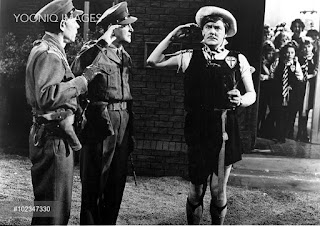I
shined my spotlight on St Trinians in the hope that it would inspire a short
story or two to add to my collection. In the end, I came up with just one,
inspired by the ideas that I formed about what it might have been to be an
innocent young actress in the 1950s.
My
new short story, ‘Fortune Favours’, turned out to be rather topical. When the
Harvey Weinstein news and all the following revelations broke, I had already
completed my first draft. But my story proves not that I have clairvoyant
properties, but that it was ever thus. The casting couch and predatory men in
power over young girls are as old as cinema itself. We all know this. It only
became news again when we discovered that it was as bad as ever when we thought
we were more enlightened. Although,
under the surface, I think we all knew that it still went on.
My
story hints that my actress character got a small part in a St Trinians film –
but this is not based on a real person. Some readers might lift an eyebrow at
the innocence that I have portrayed, but that side of her character is based on
historical fact. During my reading and researches into the 1950s it became
evident that many people went into the prescribed relationship of marriage
innocent of the mechanics of reproduction. Sex education as is taught in
schools today didn’t exist, and in many families it was just not the done thing
to discuss such matters. Jessica Mann, in her excellent book ‘The Fifties
Mystique’ (Quartet, 2012), says
“I
don’t remember being taught anything about sex at school…many of us understood
nothing about sex, nothing about what men and women did in bed.”
The
1950s St Trinians films, which turn the sixth formers into be-stockinged
sirens, is an interesting juxtaposition to this. It prompted me to explore it a
little after my investigation into what happened to the young actresses who played St Trinians pupils See Spotlight on St Trinians - Girls, Girls
So,
I hope you will download my new short story. Click here
Here’s
the blurb:
It’s
1957 and Molly Bilsthorpe, a young repertory actress, travels to London. There,
she becomes Stella Bishop and wins a place on the books of an agent. This
agent, spotting a shapely young innocent, persuades Stella to pose for nude
photographs…and to join him for a day out in Brighton. Soon, she moves into his
flat and finds herself on film sets and on stages close to, if not actually in,
the West End. When Stella finds that she
is in trouble, she turns to a fortune teller that she has been visiting. Help
comes in the form of a change in career and a move to Devon…but there are
consequences for more people than just Stella.
A
9,000 word story about the innocents and the predators of the 1950s, with a
liberal dose of palmistry and tea leaves.
(Thanks to Howard Taylor for sorting out the cover, using a vintage French postcard)

































